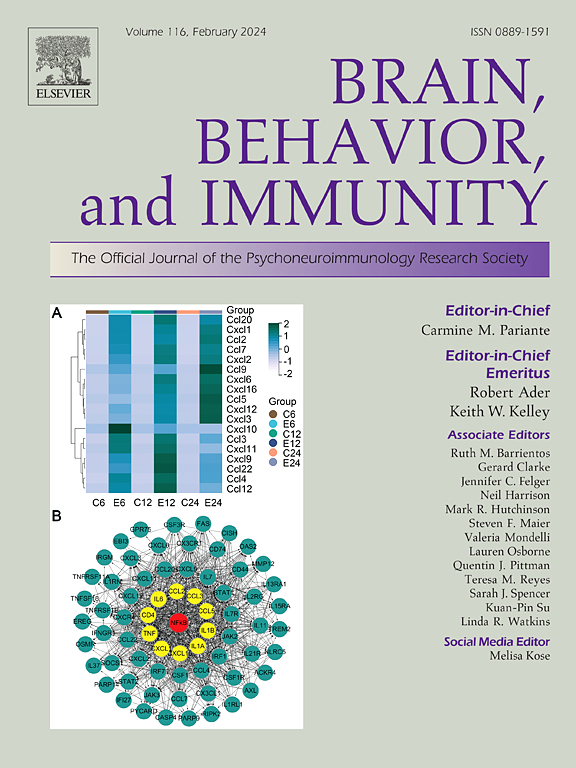社会隔离对大鼠神经内分泌、免疫状态和癌症进展的有害影响
IF 8.8
2区 医学
Q1 IMMUNOLOGY
引用次数: 0
摘要
越来越多的证据表明,人类和啮齿类动物的社会隔离(SI)与癌症发病率和死亡率的增加有关,但其中介机制仍然难以捉摸。在这里,我们研究了社会隔离对神经内分泌和免疫学的影响,以及它对天真大鼠和患癌大鼠的短期和长期生理影响。研究结果表明,与对照组相比,离体动物的体重显著下降。特别是,雌性大鼠在隔离的第一周体重明显下降。隔离大鼠的 MADB106 实验性肺转移数量明显增加。虽然离体肿瘤大鼠的死亡率较高,但出乎意料的是,它们的正位植入 MADB106 肿瘤的生长率却有所降低。对这些切除肿瘤的转录组分析表明,各种基因的表达出现了严重的下调,包括那些与促转移过程(如 EMT)相关的基因。在 SI 条件下,天真大鼠(无癌症)的 IL-6 水平升高,总 IgG 水平降低。对 TNFα 的影响是混合的,雌性增加,雄性减少。在中枢神经系统中,离体大鼠与应激反应和社会行为有关的关键脑区的基因表达发生了改变。丘脑室旁核和纹状体末端床核是受影响较大的区域。催产素、血清素和多巴胺受体的表达也发生了变化。隔离大鼠还表现出下丘脑-垂体-肾上腺(HPA)轴相关调节的更大改变,以及血浆 CORT 水平的增加。我们的研究强调了SI对转移过程的深远影响。此外,我们还讨论了SI对体温调节的潜在不利影响,强调了社会性体温调节在维持生理稳定方面的重要性,并强调了在研究中避免单一笼养做法的必要性。我们报告了神经免疫相互作用和大脑基因表达的变化,强调需要进一步研究这些潜在过程,以改善动物模型的结果,并通过增加社会支持对癌症患者进行潜在干预。本文章由计算机程序翻译,如有差异,请以英文原文为准。
Deleterious effects of social isolation on neuroendocrine-immune status, and cancer progression in rats
Accumulating evidence indicates that social isolation (SI) in humans and rodents is associated with increased cancer incidence and mortality, yet mediating mechanisms remain elusive. Here, we examine the neuroendocrine and immunological consequences of SI and its short- and long-term physiological impacts in naïve and cancer-bearing rats. Findings indicate that isolated animals experienced a significant decrease in weight compared to controls. Specifically, females showed a marked weight decrease during the first week of isolation. Isolated rats had significantly higher numbers of MADB106 experimental pulmonary metastases. Although mortality rates were higher in isolated tumor-bearing rats, unexpectedly, they exhibited a reduced growth rate of orthotopically implanted MADB106 tumors. Transcriptomic analyses of these excised tumors indicated a major downregulation in the expression of various genes, including those associated with pro-metastatic processes (e.g., EMT). In naïve rats (no cancer), levels of IL-6 increased, and total IgG levels decreased under SI conditions. A mixed effect was found for TNFα, which increased in females and decreased in males. In the central nervous system, isolated rats showed altered gene expression in key brain regions associated with stress responses and social behavior. The paraventricular nucleus of the thalamus emerged as a significantly affected region, along with the bed nucleus of the stria terminalis. Changes were observed in the expression of oxytocin, serotonin, and dopamine receptors. Isolated rats also exhibited greater alterations in hypothalamic–pituitary–adrenal (HPA) axis-related regulation and an increase in plasma CORT levels. Our study highlights the profound impact of SI on metastatic processes. Additionally, the potential detrimental effects of SI on thermoregulation were discussed, emphasizing the importance of social thermoregulation in maintaining physiological stability and highlighting the need to avoid single-caging practices in research. We report neuro-immune interactions and changes in brain gene expression, highlighting the need for further research into these underlying processes to improve outcomes in animal models and potential interventions for cancer patients through increased social support.
求助全文
通过发布文献求助,成功后即可免费获取论文全文。
去求助
来源期刊
CiteScore
29.60
自引率
2.00%
发文量
290
审稿时长
28 days
期刊介绍:
Established in 1987, Brain, Behavior, and Immunity proudly serves as the official journal of the Psychoneuroimmunology Research Society (PNIRS). This pioneering journal is dedicated to publishing peer-reviewed basic, experimental, and clinical studies that explore the intricate interactions among behavioral, neural, endocrine, and immune systems in both humans and animals.
As an international and interdisciplinary platform, Brain, Behavior, and Immunity focuses on original research spanning neuroscience, immunology, integrative physiology, behavioral biology, psychiatry, psychology, and clinical medicine. The journal is inclusive of research conducted at various levels, including molecular, cellular, social, and whole organism perspectives. With a commitment to efficiency, the journal facilitates online submission and review, ensuring timely publication of experimental results. Manuscripts typically undergo peer review and are returned to authors within 30 days of submission. It's worth noting that Brain, Behavior, and Immunity, published eight times a year, does not impose submission fees or page charges, fostering an open and accessible platform for scientific discourse.

 求助内容:
求助内容: 应助结果提醒方式:
应助结果提醒方式:


